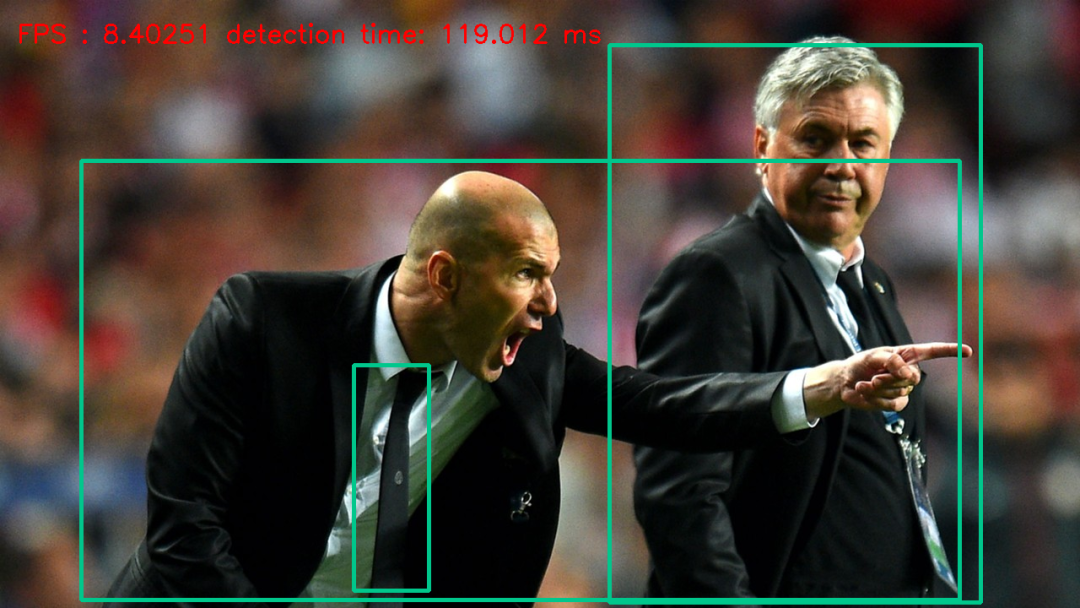前面写过一篇文章介绍了YOLOX目标检测模型,知道它是基于Pytroch而且类似与YOLOv5目标检测模型,文章链接:
比YOLOv5还厉害的YOLOX来了,官方支持OpenVINO推理
本文基于YOLOX的ONNX模型分别测试了YOLOX-Small与YOLOX-Tiny版本的模型。硬件配置与软件版本:
Win10 64位
CPU CORE i7 8thVS2017OpenVINO2021.4
模型说明
两个模型的输入与输出格式分别如下:

以YOLOX small版本为例,解释输出的内容是什么,看模型的输出图示如下:


有三个输出层,分别是8倍、16倍、32倍的降采样,输出的8400计算方法为:
80x80+40x40+20x20 = 6400+1600+400=8400分别对应640的8倍、16倍、32倍的降采样大小。85的前四个是cx、cy、w、h大小,第五个是object预测得分,后面80个是COCO类别。
看到这里就知道它跟YOLOv5的解析极其类似。然后它对图象的预测要求如下:
输入通道顺序:RGB、类型浮点数0~1之间输入的均值:0.485f, 0.456f, 0.406f输入的归一化方差:0.229f, 0.224f, 0.225f
代码实现部分
首先需要加载模型,从github上下载好对应的模型ONNX格式文件之后,首先通过IECore来加载YOLOX模型,代码如下:
std::cout << "YOLOX Demo" << std::endl;
Core ie;
std::vector<std::string> availableDevices = ie.GetAvailableDevices();
for (int i = 0; i < availableDevices.size(); i++) {
printf("supported device name : %s n", availableDevices[i].c_str());
}
// 加载检测模型
auto network = ie.ReadNetwork("D:/yolox.onnx");设置模型的输入与输出,这里需要注意,输入设置为FP32,读取输入与输出层名称,代码如下:
// 请求网络输入与输出信息
InferenceEngine::InputsDataMap input_info(network.getInputsInfo());
InferenceEngine::OutputsDataMap output_info(network.getOutputsInfo());
// 设置输入格式
std::string input_name = "";
for (auto &item : input_info) {
auto input_data = item.second;
input_name = item.first;
input_data->setPrecision(Precision::FP32);
input_data->setLayout(Layout::NCHW);
}
printf("get it n");
// 设置输出格式
std::string output_name = "";
for (auto &item : output_info) {
auto output_data = item.second;
output_name = item.first;
std::cout <<"output name: "<< item.first << std::endl;
output_data->setPrecision(Precision::FP32);
}下面就是生成三个输出层的grid,每个grid上的每个点的坐标信息,后面解析输出数据的时候需要根据index来取每个grid对应的数据
// 生成三个输出层的grid与anchor信息
std::vector<int> strides = { 8, 16, 32 };
std::vector<GridAndStride> grid_strides;
generate_grids_and_stride(IMG_W, strides, grid_strides);其中generate_grids_and_stride是我借鉴了官方的代码,这部分我感觉是可以省去的,可以从index中直接计算的,也许这样会更快点,暂时我就借用了,该方法的代码如下:
const float IMG_W = 640.0f;
struct GridAndStride
{
int gh;
int gw;
int stride;
};
void generate_grids_and_stride(int target_size, std::vector<int>& strides, std::vector<GridAndStride>& grid_strides)
{
for (auto stride : strides)
{
int num_grid = target_size / stride;
for (int g1 = 0; g1 < num_grid; g1++)
{
for (int g0 = 0; g0 < num_grid; g0++)
{
GridAndStride gs;
gs.gh = g0;
gs.gw = g1;
gs.stride = stride;
grid_strides.push_back(gs);
}
}
}
}下面就很容易啦,创建推理请求,开始执行推理,推理的解析部分,代码如下:
// 开始推理处理 - 支持图象与视频
cv::Mat image = cv::imread("D:/zidane.jpg");
inferAndOutput(image, grid_strides, input_name, output_name, infer_request);其中inferAndOutput是我的推理与解析输出结果的方法,该方法首先得到输出,然后根据index来从grid_strides里面查询对应grid的对应位置信息,原来官方的方法比较比较啰嗦,代码不够简洁,我稍微改动了一下,借助OpenVINO中OpenCV自带的NMS函数功能,重新整理一下,改成现在的方法,发现可以降低代码量,提升可读性,该方法的代码如下:
void inferAndOutput(cv::Mat &image, std::vector<GridAndStride> &grid_strides, std::string &input_name, std::string &output_name, InferRequest &infer_request) {
int64 start = cv::getTickCount();
Blob::Ptr imgBlob = infer_request.GetBlob(input_name);
float sx = static_cast<float>(image.cols) / IMG_W;
float sy = static_cast<float>(image.rows) / IMG_W;
// 推理
blobFromImage(image, imgBlob);
infer_request.Infer();
const Blob::Ptr output_blob = infer_request.GetBlob(output_name);
const float* outblob = static_cast<PrecisionTrait<Precision::FP32>::value_type*>(output_blob->buffer());
const SizeVector outputDims = output_blob->getTensorDesc().getDims();
const int num_anchors = grid_strides.size();
const int num_class = 80;
// 处理解析输出结果
std::vector<cv::Rect> boxes;
std::vector<int> classIds;
std::vector<float> confidences;
for (int anchor_idx = 0; anchor_idx < num_anchors; anchor_idx++)
{
const int grid0 = grid_strides[anchor_idx].gh; // H
const int grid1 = grid_strides[anchor_idx].gw; // W
const int stride = grid_strides[anchor_idx].stride; // stride
const int basic_pos = anchor_idx * 85;
float x_center = (outblob[basic_pos + 0] + grid0) * stride * sx;
float y_center = (outblob[basic_pos + 1] + grid1) * stride * sy;
float w = exp(outblob[basic_pos + 2]) * stride * sx;
float h = exp(outblob[basic_pos + 3]) * stride * sy;
float x0 = x_center - w * 0.5f;
float y0 = y_center - h * 0.5f;
float box_objectness = outblob[basic_pos + 4];
for (int class_idx = 0; class_idx < num_class; class_idx++)
{
float box_cls_score = outblob[basic_pos + 5 + class_idx];
float box_prob = box_objectness * box_cls_score;
if (box_prob > 0.25)
{
cv::Rect rect;
rect.x = x0;
rect.y = y0;
rect.width = w;
rect.height = h;
classIds.push_back(class_idx);
confidences.push_back((float)box_prob);
boxes.push_back(rect);
}
} // class loop
}
std::vector<int> indices;
cv::dnn::NMSBoxes(boxes, confidences, 0.25, 0.5, indices);
for (size_t i = 0; i < indices.size(); ++i)
{
int idx = indices[i];
cv::Rect box = boxes[idx];
rectangle(image, box, cv::Scalar(140, 199, 0), 4, 8, 0);
}
float fps = cv::getTickFrequency() / (cv::getTickCount() - start);
float time = (cv::getTickCount() - start) / cv::getTickFrequency();
std::ostringstream ss;
ss << "FPS : " << fps << " detection time: " << time * 1000 << " ms";
cv::putText(image, ss.str(), cv::Point(20, 50), 0, 1.0, cv::Scalar(0, 0, 255), 2);
cv::imshow("OpenVINO2021.4+YOLOX Demo@JiaZhiGang", image);
}运行与测试
首先用YOLOv5的一张测试图象测试一下,基于YOLOX的samll版本模型运行结果如下:

跟YOLOV5 small版本测试结果完成一致,毫无违和感!
视频测试(YOLOX Small版本模型)运行结果如下:

感觉没有YOLOv5的small版本推理速度快(在我的机器上)!还需进一步优化输出解析代码。
视频测试(YOLOX Tiny版本模型)运行结果如下:

CPU果然可以30+ FPS的。
最后
以上就是执着大船最近收集整理的关于OpenVINO2021.4+YOLOX目标检测模型部署测试的全部内容,更多相关OpenVINO2021内容请搜索靠谱客的其他文章。








发表评论 取消回复